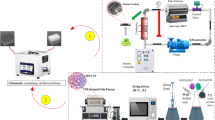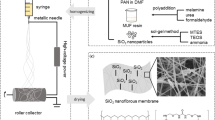Abstract
Developing efficient sorbent materials is of worldwide importance to protect the environment against frequent oil spills and chemical leakage accidents. A simple and low-cost process was adopted to prepare hydroxylated BN bonded with SiO2 sol and then embed BN/SiO2 on polyurethane (PU) foam(BN/SiO2@PU) via dip-coating. BN/SiO2@PU could float on water due to its hydrophobicity. Absorption tests were performed to test its performance using various organic solvents or oil. Comparing with BN/SiO2 aerogel, BN@PU and SiO2@PU, BN/SiO2@PU had a high absorption rate and a high absorption capacity for both organic solvents and oil, and could absorb as much as 40 times its weight. It was also able to selectively absorb oil or organic solvents from an oil–water mixture with separation efficiency higher than 95% and had good recyclability of 20 absorption cycles even towards commercial waste oil. Furthermore, BN/SiO2@PU with high temperature stability can be used under harsh condition. The performance of the prepared adsobent reported is competitive and superior to other reported materials, confirming its potential application in water treatment.




Similar content being viewed by others
References
E. Unur, Functional nanoporous carbons from hydrothermally treated biomass for environmental purification. Microporous Mesoporous Mater. 168, 92–101 (2013). https://doi.org/10.1016/j.micromeso.2012.09.027
C.R. Park, S.J. Yang, J.H. Kang, H. Jung, T. Kim, Preparation of a freestanding, macroporous reduced graphene oxide film as an efficient and recyclable sorbent for oils and organic solvents. J. Mater. Chem. A. 1, 9427–9432 (2013). https://doi.org/10.1039/c3ta10663b
M.A. Shannon, P.W. Bohn, M. Elimelech, J.G. Georgiadis, B.J. Marĩas, A.M. Mayes, Science and technology for water purification in the coming decades. Nature 452, 301–310 (2008). https://doi.org/10.1038/nature06599
J. Yuan, X. Liu, O. Akbulut, J. Hu, S.L. Suib, J. Kong, F. Stellacci, Superwetting nanowire membranes for selective absorption. Nat. Nanotechnol. 3, 332–336 (2008). https://doi.org/10.1038/nnano.2008.136
H. Bi, Z. Yin, X. Cao, X. Xie, C. Tan, X. Huang, B. Chen, F. Chen, Q. Yang, X. Bu, X. Lu, L. Sun, H. Zhang, Carbon fiber aerogel made from raw cotton: A novel, efficient and recyclable sorbent for oils and organic solvents. Adv. Mater. 25, 5916–5921 (2013). https://doi.org/10.1002/adma.201302435
X.C. Gui, Z.P. Zeng, Z.Q. Lin, Q.M. Gan, R. Xiang, Y. Zhu, A.Y. Cao, Z.K. Tang, Magnetic and Highly Recyclable Macroporous Carbon Nanotubes for Spilled Oil Sorption and Separation. ACS Appl. Mater. Interfaces. 5, 5845–5850 (2013). https://doi.org/10.1021/am4015007
Y. Tao, H. Kanoh, L. Abrams, K. Kaneko, Mesopore-Modified Zeolites : Preparation, Characterization, and Applications. Chem. Rev. 106, 896–910 (2006). https://doi.org/10.1021/cr040204o
I.A.W. Tan, B.H. Hameed, A.L. Ahmad, Equilibrium and kinetic studies on basic dye adsorption by oil palm fibre activated carbon. Chem. Eng. J. 127, 111–119 (2007). https://doi.org/10.1016/j.cej.2006.09.010
V. Kumar, K. Vellingiri, D. Kukkar, S. Kumar, K.H. Kim, Recent advances and opportunities in the treatment of hydrocarbons and oils: Metal-organic frameworks-based approaches. Crit. Rev. Environ. Sci. Technol. 49, 587–654 (2019). https://doi.org/10.1080/10643389.2018.1554402
J.T. Korhonen, M. Kettunen, R.H.A. Ras, O. Ikkala, Hydrophobic nanocellulose aerogels as floating, sustainable, reusable, and recyclable oil absorbents. ACS Appl. Mater. Interfaces. 3, 1813–1816 (2011). https://doi.org/10.1021/am200475b
J. Lin, F. Tian, Y. Shang, F. Wang, B. Ding, J. Yu, Facile control of intra-fiber porosity and inter-fiber voids in electrospun fibers for selective adsorption. Nanoscale. 4, 5316–5320 (2012). https://doi.org/10.1039/c2nr31515g
J. Lin, F. Tian, Y. Shang, F. Wang, B. Ding, J. Yu, Z. Guo, Co-axial electrospun polystyrene/polyurethane fibres for oil collection from water surface. Nanoscale. 5, 2745–2755 (2013). https://doi.org/10.1039/c3nr34008b
X. Dong, J. Chen, Y. Ma, J. Wang, M.B. Chan-Park, X. Liu, L. Wang, W. Huang, P. Chen, Superhydrophobic and superoleophilic hybrid foam of graphene and carbon nanotube for selective removal of oils or organic solvents from the surface of water. Chem. Commun. 48, 10660–10662 (2012). https://doi.org/10.1039/c2cc35844a
D.D. Nguyen, N.H. Tai, S.B. Lee, W.S. Kuo, Superhydrophobic and superoleophilic properties of graphene-based sponges fabricated using a facile dip coating method. Energy Environ. Sci. 5, 7908–7912 (2012). https://doi.org/10.1039/c2ee21848h
Y. Chu, Q.M. Pan, Three-Dimensionally Macroporous Fe/C Nanocomposites As Highly Selective Oil-Absorption Materials. ACS Appl. Mater. Interfaces. 4, 2420–2425 (2012). https://doi.org/10.1021/am3000825
A. Li, H.X. Sun, D.Z. Tan, W.J. Fan, S.H. Wen, X.J. Qing, G.X. Li, S.Y. Li, W.Q. Deng, Superhydrophobic conjugated microporous polymers for separation and adsorption. Energy Environ. Sci. 4, 2062–2065 (2011). https://doi.org/10.1039/c1ee01092a
J.-D. Brassard, D.K. Sarkar, J. Perron, Fluorine Based Superhydrophobic Coatings. Appl. Sci. 2, 453–464 (2012). https://doi.org/10.3390/app2020453
B.X. Tian, T. Verho, R.H.A. Ras, Moving superhydrophobic surfaces toward real-world applications. Science 352, 142–143 (2016). https://doi.org/10.1126/science.aaf2073
M. Spaeth, W. Barthlott, Lotus-Effect®: Biomimetic super-hydrophobic surfaces an their application. Adv. Sci. Technol. 60, 38–46 (2008). https://doi.org/10.4028/www.scientific.net/AST.60.38
X. Zhang, F. Shi, J. Niu, Y. Jiang, Z. Wang, Superhydrophobic surfaces : from structural control to functional application. J. Mater. Chem. 18, 621–633 (2008). https://doi.org/10.1039/b711226b
E. Kobina, D. Kobina, X. Lv, B. Liu, X. Xiao, Recent development in the fabrication of self-healing superhydrophobic surfaces. Chem. Eng. J. 373, 531–546 (2019). https://doi.org/10.1016/j.cej.2019.05.077
S. Nanofibers, L. Feng, Y. Song, J. Zhai, B. Liu, J. Xu, L. Jiang, D. Zhu, Creation of a superhydrophobic surface from an amphiphilic polymer. Angew. Chemie—Int. Ed. 42, 800–802 (2003). https://doi.org/10.1002/anie.200390212
X. Lü, Z. Cui, W. Wei, J. Xie, L. Jiang, J. Huang, J. Liu, Constructing polyurethane sponge modified with silica/graphene oxide nanohybrids as a ternary sorbent. Chem. Eng. J. 284, 478–486 (2016). https://doi.org/10.1016/j.cej.2015.09.002
Y. Zhang, S. Wei, F. Liu, Y. Du, S. Liu, Y. Ji, T. Yokoi, T. Tatsumi, F.S. Xiao, Superhydrophobic nanoporous polymers as efficient adsorbents for organic compounds. Nano Today. 4, 135–142 (2009). https://doi.org/10.1016/j.nantod.2009.02.010
X. Zhang, L. Xu, Y. Shen, L. Wang, Y. Ding, One-Step Fabrication of Self-Healing and Durable Superhydrophobic Cotton Fabrics Based on Silica Aerogel. J. Nanosci. Nanotechnol. 18, 7721–7731 (2018). https://doi.org/10.1166/jnn.2018.15548
Q. Zhu, Q. Pan, F. Liu, Facile removal and collection of oils from water surfaces through superhydrophobic and superoleophilic sponges. J. Phys. Chem. C. 115, 17464–17470 (2011). https://doi.org/10.1021/jp2043027
T. Sainsbury, A. Satti, P. May, Z. Wang, I. McGovern, Y.K. Gun’ko, J. Coleman, Oxygen radical functionalization of boron nitride nanosheets. J. Am. Chem. Soc. (2012). https://doi.org/10.1021/ja3080665
J. Gu, H. Fan, C. Li, J. Caro, H. Meng, Robust Superhydrophobic/Superoleophilic Wrinkled Microspherical MOF@rGO Composites for Efficient Oil-Water Separation. Angew. Chemie - Int. Ed. (2019). https://doi.org/10.1002/anie.201814487
C. Liu, J. Yang, Y. Tang, L. Yin, H. Tang, C. Li, Versatile fabrication of the magnetic polymer-based graphene foam and applications for oil-water separation. Colloids Surfaces A Physicochem. Eng. Asp. 468, 10–16 (2015). https://doi.org/10.1016/j.colsurfa.2014.12.005
C. Yu, C. Yu, L. Cui, Z. Song, X. Zhao, Y. Ma, L. Jiang, Facile Preparation of the Porous PDMS Oil-Absorbent for Oil/Water Separation. Adv. Mater. Interfaces. (2017). https://doi.org/10.1002/admi.201600862
Q. Zhu, Y. Chu, Z. Wang, N. Chen, L. Lin, F. Liu, Q. Pan, Robust superhydrophobic polyurethane sponge as a highly reusable oil-absorption material. J. Mater. Chem. A. 1, 5386–5393 (2013). https://doi.org/10.1039/c3ta00125c
G. Hayase, K. Kanamori, M. Fukuchi, H. Kaji, K. Nakanishi, Facile Synthesis of Marshmallow-like Macroporous Gels Usable under Harsh Conditions for the Separation of Oil and Water. Angew. Chemie - Int. Ed. 52, 1986–1989 (2013). https://doi.org/10.1002/anie.201207969
F. Chen, Y. Lu, X. Liu, J. Song, G. He, M.K. Tiwari, C.J. Carmalt, I.P. Parkin, Table Salt as a Template to Prepare Reusable Porous PVDF–MWCNT Foam for Separation of Immiscible Oils/Organic Solvents and Corrosive Aqueous Solutions. Adv. Funct. Mater. (2017). https://doi.org/10.1002/adfm.201702926
J. Gao, X. Huang, H. Xue, L. Tang, R.K.Y. Li, Facile preparation of hybrid microspheres for super-hydrophobic coating and oil-water separation. Chem. Eng. J. 326, 443–453 (2017). https://doi.org/10.1016/j.cej.2017.05.175
Y. Li, Y.A. Samad, K. Polychronopoulou, S.M. Alhassan, K. Liao, Carbon Aerogel from Winter Melon for Highly E ffi cient and Recyclable Oils and Organic Solvents Absorption. ACS Sustain. Chem. Eng. (2014). https://doi.org/10.1021/sc500161b
B. Wang, J. Li, G. Wang, W. Liang, Y. Zhang, L. Shi, Z. Guo, W. Liu, Methodology for Robust Superhydrophobic Fabrics and Sponges from In Situ Growth of Transition Metal / Metal Oxide Nanocrystals with Thiol Modification and Their Applications in Oil / Water Separation. ACS Appl. Mater. Interfaces. 5, 1827–1839 (2013)
Z. Wu, C. Li, H. Liang, Y. Zhang, X. Wang, J. Chen, S. Yu, Carbon nanofiber aerogels for emergent cleanup of oil spillage and chemical leakage under harsh conditions. Sci. Rep. (2014). https://doi.org/10.1038/srep04079
J. Xiao, W. Lv, Y. Song, Q. Zheng, Graphene / nanofiber aerogels : performance regulation towards multiple applications in dye adsorption and oil / water separation. Chem. Eng. J. (2017). https://doi.org/10.1016/j.cej.2017.12.156
H. Bi, X. Xie, K. Yin, Y. Zhou, S. Wan, L. He, F. Xu, F. Banhart, L. Sun, R.S. Ruoff, Spongy graphene as a highly effi cient and recyclable sorbent for oils and organic solvents. Adv. Funct. Mater. (2012). https://doi.org/10.1002/adfm.201200888
Y. Liu, J. Ma, T. Wu, X. Wang, G. Huang, Y. Liu, H. Qiu, Y. Li, W. Wang, J. Gao, Cost-effective reduced graphene oxide-coated polyurethane sponge as a highly efficient and reusable oil-absorbent. ACS Appl. Mater. Interfaces. 5, 10018–10026 (2013). https://doi.org/10.1021/am4024252
K. Jayaramulu, K. Kumara, R. Datta, C. Rçsler, M. Petr, M. Otyepka, R. Zboril, R.A. Fischer, Biomimetic Superhydrophobic / Superoleophilic Highly Fluorinated Graphene Oxide and ZIF-8 Composites for Oil—Water Separation. Angew. Chemie—Int. Ed. 55, 1178–1182 (2016). https://doi.org/10.1002/anie.201507692
H. Cong, X. Ren, P. Wang, S. Yu, Macroscopic Multifunctional Graphene-Based Hydrogels and Aerogels by a Metal Ion Induced Self-Assembly Process. ACS Nano 6, 2693–2703 (2012)
Acknowledgements
We acknowledge the Opening Project of Henan Province Key Laboratory of Water Pollution Control and Rehabilitation Technology (CJSZ2018002), Special Fund of Jiangsu Province for the Transformation of Science and Technology and Achievements in Transport (2018Y29).
Author information
Authors and Affiliations
Corresponding authors
Ethics declarations
Conflicts of interest
The authors declare no conflict of interest.
Additional information
Publisher's Note
Springer Nature remains neutral with regard to jurisdictional claims in published maps and institutional affiliations.
Electronic supplementary material
Below is the link to the electronic supplementary material.
Rights and permissions
About this article
Cite this article
Sam, E.K., Sam, D.K., Chen, J. et al. Hydrophobic porous BN/SiO2@PU as ternary adsorbents for efficient oil/water separation. J Porous Mater 27, 1149–1158 (2020). https://doi.org/10.1007/s10934-020-00892-2
Published:
Issue Date:
DOI: https://doi.org/10.1007/s10934-020-00892-2




